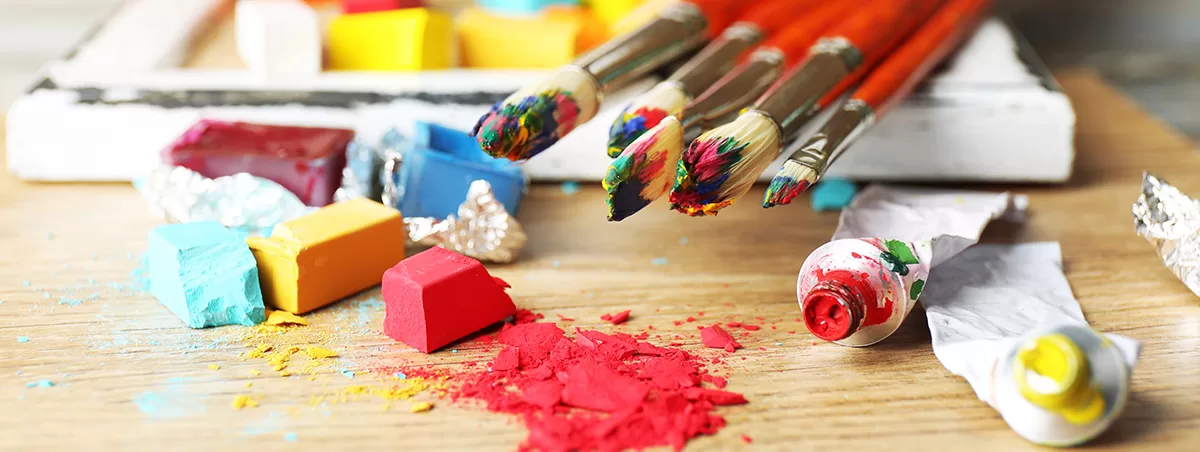Visual Arts: Definition, Types, Elements, 2D Art vs. 3D Art, Filmmaking and Game Design
Visual art refers to work that is enjoyed entirely, or mostly, through the eyes. This includes fields like painting, sculpture, architecture, film, and many more. The types of visual arts are representational, abstract art and non-objective. The elements of visual arts are the basic building blocks of these works, and they each serve a role in the artist’s toolkit. Famous painters have used these simple elements to create masterpieces. We will explain a “visual arts” definition, examine the difference between 2D and 3D art, and see 3D and 2D art examples — from drawing to collage to video game design and beyond.
From the paintings of Frida Kahlo to the graffiti of Banksy, from MoMA to Minecraft, visual arts is everywhere. It is a field of staggering depth and breadth, with so many riches waiting to be discovered.
But because it is such an enormous world, it can be difficult to get a firm grasp on what we mean by “visual arts.” And it can be even more difficult to get a feel for all of the interesting avenues to explore there.
This guide is meant to familiarize you with what exactly visual arts is, what the elements are that make it up, as well as what disciplines are included under its banner.
What Is Visual Art?
Visual art consists of artwork that is entirely or in part appreciated through sight. That includes painting, sculpture, architecture, photography, graphic design, fashion design, film, and more. The forms or types of visual arts are:
-
- Representational or figurative art: based on real subjects or events, for example, realism
- Abstract art: aims to represent real subjects in a different way from reality, for example, impressionism
- Non-objective or non-representational: does not depict anything from reality — often mistaken for abstract art
As you can see, visual art is about creating visual experience — whether for a setting like a gallery, as in fine art, or for a product, as in the applied art of graphic design.
To complicate things, there are a few caveats. Performance art, like dancing, typically doesn’t fall under the visual arts. Although, still others believe it does.
There are more artforms that typically don’t fall under the term visual art, due only to tradition. These used to include many arts and crafts, but this is continuing to change as the art world becomes more inclusive and artists become more interdisciplinary.
Visual art has two main categories to keep in mind:
-
- Fine art: This includes anything that is made purely to be seen as art, like painting, film, and sculpture.
- Applied art: This is visual art that has practical components, like interior design, architecture, and decorative art.
As technological advances open up possibilities for artists, new forms of visual art are always being created. Consider the rise of digital art, or more recently the rise of AI-generated art (artificial intelligence art generators). Though these use much different tools than other forms of visual art, they share the core mission of making works that are primarily enjoyed through the eyes.
What Is the Main Focus of Visual Art?
Visual artists, no matter what form they are working in, are trying to create visual experiences for their audience.
This experience could be emotional, intellectual, spiritual, political, or some combination of these. That means visual artists need to communicate with the audience through their aesthetic — manipulating their work using elements like color, line, composition, texture, and form to produce a feeling.
By depicting things a certain way, visual artists can create certain feelings in the viewer. That connection between the way something looks and how that makes us feel is the most important concern for all visual artists.
Visual Elements of Art
Painting is easy when you don’t know how, but very difficult when you do. — Edgar Degas
The visual elements of art are a set of features in visual art. These features are tools at the artist’s disposal and also ways for viewers to understand what they are seeing. It is with these simple features that every stunning masterpiece was created, along with every billboard design and video game character.
To help us understand the elements, we will feature famous paintings that illustrate the power that these have. But remember, in almost any given painting, an artist is using many elements to great effect — quite often, they use every element with purpose.
Line
Let’s begin with what is perhaps the simplest element. The line is a continuous mark between two points.

Les Trois Baigneuses by Henry Matisse [Courtesy of Wikipedia]
In Les trois baigneuses (1907), Henri Matisse uses bold outlines of the bathers, setting them off from the background. By using these bold lines, Matisse helps emphasize the soft features of the bathers — notice their round shoulders.
Lines make up so much of visual art that it can be easy to forget them, yet they form the basis of everything else.
Shape
Shapes are created by enclosing a space in lines. Consider your basic shapes from kindergarten: the square, the circle, the triangle, etc. But shapes can, of course, become much more complicated. Consider the bathers in the example above. Their body outlines are shapes.
Shapes are always two-dimensional. But with the right use of color or texture (as we’ll see below), an artist can make them appear three-dimensional. But what if you’re working in a visual art that is three dimensional? Then you are working in forms.
Form
A form is a three-dimensional feature. It will have height, length, and depth. A sphere, cube, and pyramid are forms, just as the body of a tree is a form (as long as it is 3D).
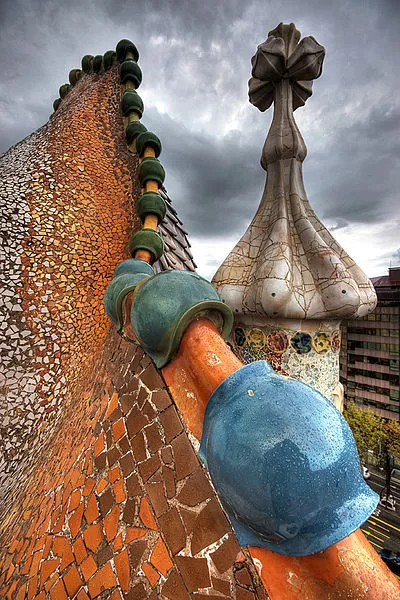
Roof Architecture at Casa Batllo by Antoni Gaudí [Courtesy of Wikimedia]
Forms can be arranged in exquisitely complex ways. Antoni Gaudí was a master of form. His architecture explores organic forms in built environments. In the above detail from the roof of Casa Batlló, you can see how Gaudí combines forms from the natural world like tortoise shells along the curving roof.
Color
Color is made up of hues (like red, yellow, green, etc.) that can be mixed with black (creating a shade), white (creating a tint), or grey (creating a tone). Pure neutral colors are achieved by mixing black, white and/or grey. Color is a great way to add “life” to a work of art, but it can also add detail. Shadows can be created by painting part of a shape in a bright color, with another part painted in a shade, creating the illusion of three-dimensions.
Value (or Light)
Value refers to the relative darkness or lightness of a color or an area. In truth, this is deeply related to color, but people often break it out into its own element. To get a sense of the values in a work of art, take a black-and-white photo of it with your smartphone. What you will see is a value map of the work, showing how the artist uses the difference in values to create emphasis, realism, or some other effect.
Space and Perspective
Space refers to everything in a work of visual art related to area. That includes:
-
- Perspective: how things look at a distance to the viewer
- Proportion: the relative size of objects (i.e. smaller or larger)
Space can also denote the use of area:
-
- Positive space: area in a work with a subject
- Negative space: area without a subject
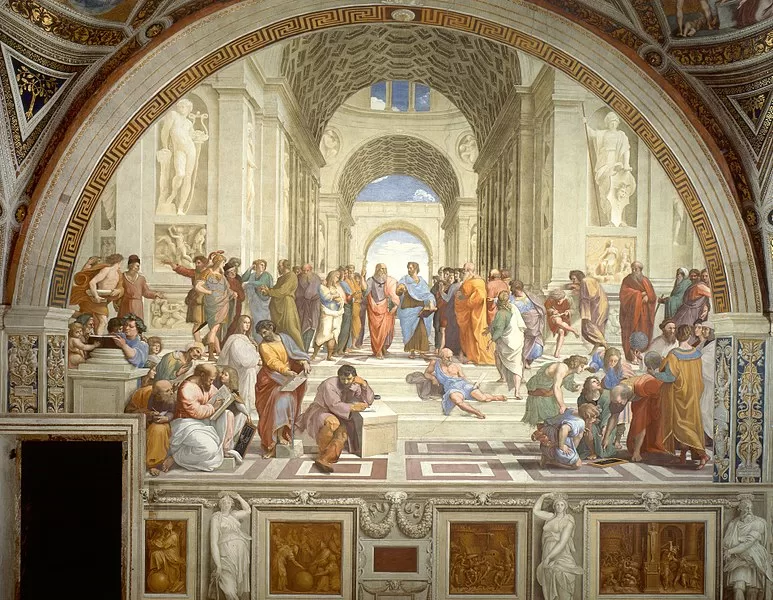
The School of Athens by Raffaello (Raphael) [Courtesy of Wikimedia]
In Raphael’s The School of Athens (1511), space and perspective are used to create an amazing sense of depth. He does this by lining up the human subjects in staggered rows and using single-point perspective on the commanding architecture above, so that it shrinks down to a single point as it moves away from the viewer.
Texture
In many forms of visual art, the artist creates an image using some kind of marking. This creates a visual texture on the work.
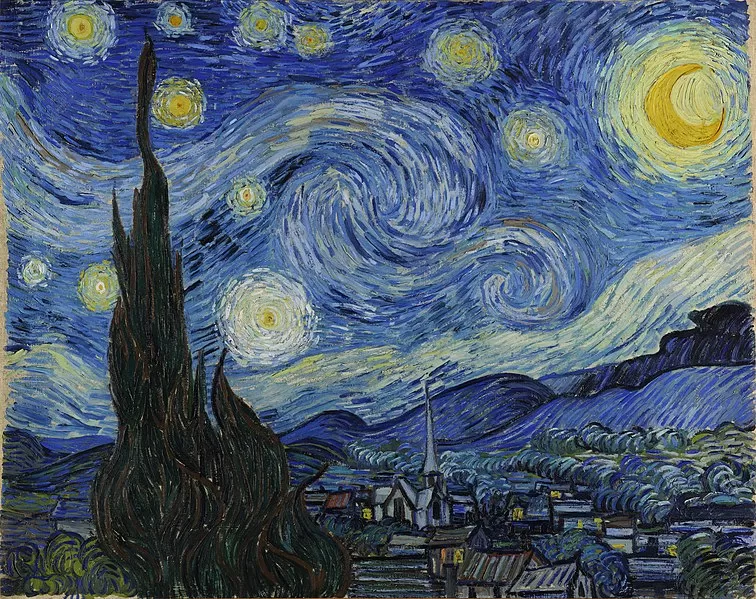
Starry Night by Van Gogh [Courtesy of Wikipedia]
This texture can be very real — what we call tactile. In Vincent Van Gogh’s masterpiece The Starry Night (1889), the artist applied paint in thick layers. This produced a real texture. If you visit the Museum of Modern Art in New York City, you could actually reach out and touch the surface of the work and feel the dynamic texture — but the security guards frown on that kind of behavior.
But texture can also be implied. That is, the eye can think it sees texture when really it is created (or exaggerated) by the use of other elements like color and line.
Composition
Composition is the arrangement of elements in a work. — Crocker Art Museum
This is perhaps the highest level of the elements, as it guides the use of all the others. By arranging what is depicted in a certain way, artists can emphasize particular parts of their work.
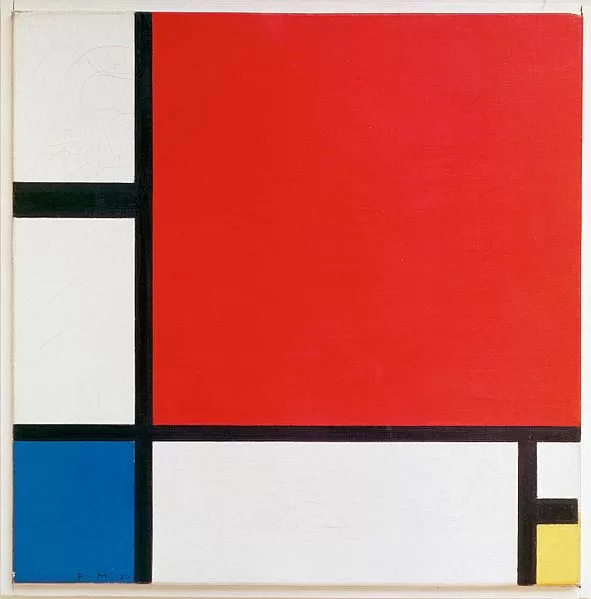
Composition II in Red, Blue, and Yellow by Piet Mondrian [Courtesy of Wikimedia]
In Composition II in Red, Blue, and Yellow (1930), Piet Mondrian created a work that relies heavily on composition and color to move the viewer. The arrangement is precise, with bold colors taking up differing amounts of space, balancing the canvas.
This masterpiece of abstract art gives us a shining example of just how compelling composition can be in its own right.
Other Tools
Apart from the elements of visual art outlined above, artists have a couple more tools at their disposal that can really help them when creating.
One of the most powerful of these is color theory: the study of the nature of color and the ways they interact with each other.
This study into color produced the color wheel, where different hues are arranged in a circle, each one sitting between the colors it is most closely related to. This allows artists to quickly see complementary colors (these sit on the opposite sides of the color wheel) and other interesting relationships.

Color Wheel [Courtesy of Wikimedia]
The color wheel also comes in handy when artists work with color mixing. If we look at the wheel pictured above, we see that between the purely red and purely blue area sits purple. So then we know that if we mix red and blue, we should get purple.
Of course, nothing is perfect, and the pigments used in paints are not always capable of following the color wheel exactly. This is why many painters will create tests of their color mixes to be able to see the exact outcome of combining two paints ahead of time.
2D Art vs. 3D Art
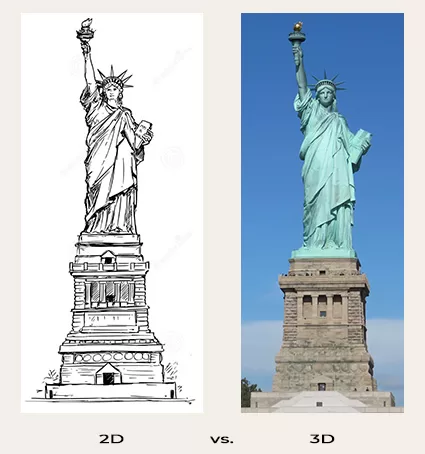
Statue of Liberty [Courtesy of Dreamstime and Wikimedia]
The major division in visual art is between two-dimensional works and three-dimensional ones.
It should be mentioned, though, that many artists work in both. Art history is filled with famous painters who also made sculpture. For instance, Salvador Dali is known for his unique paintings, but he also created surrealist sculpture — like a telephone with a lobster on top. Most artists will experiment in many forms.
Nevertheless, these two sides of visual art make different demands on the artist and produce very different kinds of art. Let’s look at both sides in depth.
What is the difference between 2D and 3D art? The main difference is that works of 2D art exist on a flat plane, while works of 3D art are objects. Examples of 2D art are paintings, posters, sketches, comics, illustrations, prints, and photographs. Examples of 3D art are buildings, animations, wood carvings, sculptures, video games and virtual reality.
2D art must create the illusion of perspective and dimensionality; on the other hand, 3D art creates objects that extend beyond the plane.
2D art is represented in two dimensions: height and width, but not depth. 2D art is like the Renaissance paintings of Raphael. Artists can also explore the possibilities of a flat plane — like the abstract expressionist paintings of Mark Rothko. Though it might seem limiting to be stuck in 2D, it also presents the ability to depict entire worlds in unique styles and from insightful perspectives.
What all 2D artists have in common is their use of the frame — the technique of presenting certain visual elements from a particular point-of-view. Because the work is only 2D, audiences can’t look at just any part of a scene, they must take in only what the artist wants them to.
3D art is represented in three dimensions: height, width, and depth. But while this opens up opportunities, it also means that the artist doesn’t have as much control over how viewers see their work. You can walk around a sculpture or a building and look at the elements from any angle you want, presenting unique challenges for the artist.
This also means that enjoying 3D art engages physical movement and choices made by the viewer, something that many creators are able to use to their advantage.
To get a better understanding of the difference between 2D and 3D art, let’s look at both sides in depth.
What is 2D Art
Two-dimensional art means flat (or virtually flat) images. When we think of a wall art abstract painting, it’s usually 2D. While this might seem very limiting, there are many, many ways artists can do this. Below, we will describe several important fields in 2D art, including practices and materials.
Dry and Liquid Media
To produce a 2D image, there are two kinds of material (media) that you can use:
-
- Dry: any tool that creates a line by leaving dry material behind on the surface, this can be smudged and rubbed (e.g. charcoal, graphite pencils, pastels)
- Wet: any tool that creates a line by leaving pigment that is in a liquid (e.g. acrylic painting, oil painting, watercolor)
Drawing
Drawing is the foundation of 2D art. This is the production of art by creating marks on a surface. Every doodle you ever made was a drawing.
There are different functions of drawing:
-
- Create the basis or outline for another work of art (like a painting)
- Create a finished work of art
There are artists from every field who make a regular habit of creating sketches. This is often seen as a foundational practice that aids an artist in everything else they do.
But drawing can also be great work in its own right and has given birth to entire genres. Line art, for instance, contains works made in distinct lines, foregoing color and usually backgrounds.
There are many media that use drawing as the main technique, including:
-
- Graphite: this includes most drawing pencils
- Charcoal: bound organic matter that produces sticks that make rich, black markings
- Pastel: pigment held in a binder that produces sticks that can be used to draw on a surface

La Toilette by Edgar Degas [Courtesy of Wikimedia]
The impressionist painter Edgar Degas worked extensively in pastel and oil, and produced some of the transcendent works of his generation.
Painting Media
Painting is the most recognizable of the 2D arts, and it is likely the first thing you think of when you hear the word “art.”
Being such a notable endeavor, people have developed many different ways to paint — both in the process and in the materials.
Some of the most common painting media include:
-
- Oil painting: an oil, usually linseed oil, is used to suspend pigments, resulting in a very slow drying paint which can be thinned with solvents like turpentine and glossed over to increase shine
- Acrylic painting: an acrylic polymer emulsion is used to suspend pigments, these have many additives to increase the ease of use, the resulting paint has bright colors and dries quickly
- Watercolor: these use water to suspend pigments
Pigment can be suspended in many other ways. Tempera, for instance, uses egg yolks as a water-soluble binder for its pigments. But by and large, the above three are the major media.
Depending on what media you use, your process will change greatly. Because oils dry so slowly, oil painting takes place over a longer period of time. This allows a painter to adjust a painting for days, even weeks. For this reason, people painting on the go typically prefer a fast-drying medium like acrylic or watercolor.
SIDENOTE: Some artists will pick a painting medium based on their project’s needs. Or, they will fall in love with a certain process and work around any hurdles that come their way.
Printmaking
Printmaking is a varied landscape unto itself. The act of transferring an image from one surface to another was long relegated to wood cuts and similar methods. But the 20th century saw a rise of new technologies in a diversity of processes.
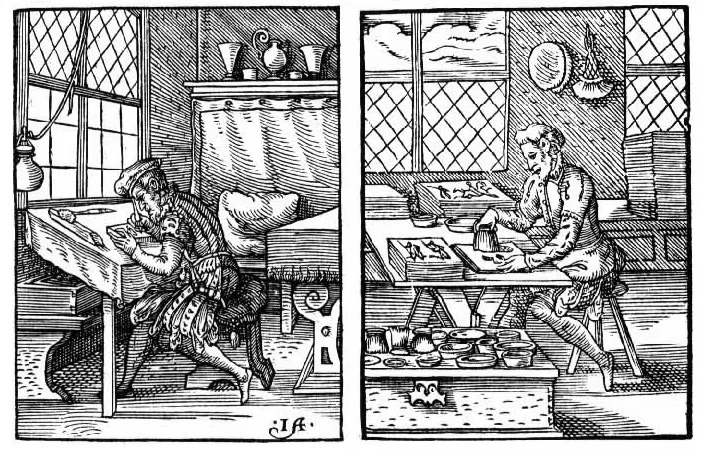
Woodcut [Courtesy of Wikimedia]
Pop art made great use of these, with Andy Warhol in particular making a name for himself through silkscreen prints. But the methods run far afield from there. Different methods of printmaking include:
-
- Relief print: a plate is created with raised lines, ink is applied to these raised lines and then this plate is pressed onto paper or some other substrate, creating an image
- Intaglio print: this is the reverse of a relief print, where lines are etched into a plate, and these etchings are then filled with ink and transferred to a page
- Silkscreen print: screens are made where parts of the screen allow ink to go through and other parts block ink, the screen is then placed over the material you are printing on and ink is dragged across — for multi-color projects, a screen will be made for every color
- Lithography print: a plate is drawn on with an gum or wax, water is then placed on the plate, oil inks are then applied, which repel from the water and only attach to the drawing
- Giclee print: these are created with inkjet printers using archival quality pigments on archival quality paper
- Stencil print: a pattern is cut out of a thin surface and then placed over your printing material, paint or ink can then be applied easily over this pattern, leaving only the cut sections on the material
- Block prints: an image is carved in relief in a block of linoleum, wood, or some other medium, ink is then applied to the surface and the block is pressed on the printing material
SIDENOTE: There are many other forms of printmaking beyond these, but the above cover many of the most popular forms of printmaking.
Often, the printmaker will choose how they print based on what they want to print on. A canvas print will require a different process than a paper print.
Collage
A collage is created by assorting pieces of other visual works to create a new work of art. These pieces can be taken from newspapers, magazines, painted canvases, and anything else the artist can think of.
This can be a form of mixed media art, as we’ll see below.
Mixed Media
Mixed media refers to artwork that contains more than one medium. If oil paints and prints are used in the same work, that is mixed media. A very common form is an ink drawing that also employs watercolors.
Graphic Design
On the applied side of 2D art stands graphic design. Graphic design covers all design that seeks to communicate a specific message to a group of people for a specific purpose. Political pamphlets, restaurant menus, and wayfinding signs in an airport all require graphic design.
Today, graphic designers typically use digital workspaces like Adobe Photoshop, Illustrator, and InDesign to create their designs. But graphic designers also use free tools like GIMP, Pixlr, and Google Draw.
Graphic design is closely linked to user experience, the study of how people interact with a certain product or designed space, like a website, app, or even putting together Ikea furniture. Graphic design is often used to alleviate problems users have. For example, they might color code options or create feedback animations so users know that their actions have registered.
What is 3D Art
3D visual art brings us into the world of making objects, which includes its own impressive array of methods and forms.
Arts and Crafts
Arts and crafts refer to the fine art movement pushing for the recognition of useful objects created with great artistry. The legacy of sexism in Western societies led to a frequent split between the “fine arts” and “craft,” which were coded as masculine and feminine, respectively. Today, many artists working in craft are finally receiving the recognition they deserve, although there is work to be done.
Some of the most common crafts include:
-
- Ceramics
- Wood
- Metal
- Fiber
- Glass
All of the above materials can also be used to make traditional fine art, as well, including sculpture.
Sculpture
Sculpture, an artistic form in which hard or plastic materials are worked into three-dimensional art objects. The designs may be embodied in freestanding objects, in reliefs on surfaces, or in environments ranging from tableaux to contexts that envelop the spectator. — Britannica

Pieta by Michelangelo [Courtesy of Wikimedia]
Sculpture refers to any three-dimensional art that exists in the real world. That makes it fairly broad. As we saw above, it can be made in a wide range of material — a list that can also include marble, limestone, bronze, ice, sand, and beyond.
Freestanding sculpture refers to work that stands on its own, rather than being hung as a wall decoration or fastened to any other surface.
Relief sculpture is carved in relief out of a surface, leaving a flat object with the depicted subjects raising out of it.
The process of creating sculpture can be:
-
- Additive: where material is added and built up into the object, like clay
- Subtractive: where material is taken away to make the object, like chiselling limestone
Many sculptures are first made in an additive process. This is then used to create a cast which can be filled with poured metal resulting in a copy. Today, many artists also use computer aided design programs and 3D printers to create their sculptures.
Architecture
Architecture is the design of built structures — usually buildings meant for some kind of occupation. The discipline of architecture uses the elements of visual art but must also take into account realities of construction, principles of engineering, and relevant legal codes.
Filmmaking and Game Design
Last on our list, but certainly not least, are the odds and ends of visual art. These include many fine forms that just don’t quite fit perfectly within a 2D/3D model.
Filmmaking
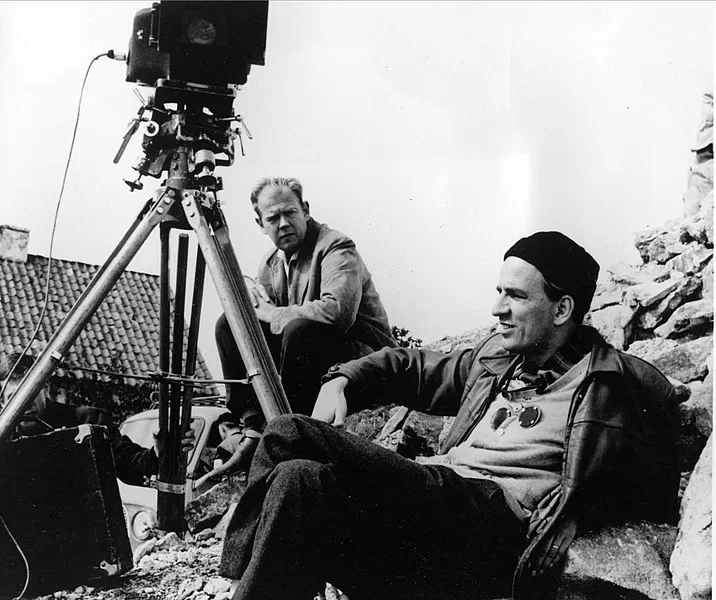
Ingmar Bergman & Sven Nykvist Filmmaking [Courtesy of Wikimedia]
A film itself is a visual art, but the process itself is much more complicated than a single form. Within filmmaking fall many visual art disciplines, including:
-
- Cinematography: the production of cinematic images using atmosphere, framing, and manipulation of the lens
- Editing: the mixing of filmed sequences to create a greater whole
- Production design: the design of the elements of a production including sets, wardrobe, etc.
- Visual effects: from practical effects like squibs and advanced puppets to computer generated effects
- Animation: the creation of images in a series to produce the illusion of movement
Game Design
Game design is the art of applying design and aesthetics to create a game for entertainment or for educational, exercise, or experimental purposes. — Wikipedia

Minecraft Video Game Mediablock Buzzybees [Courtesy of Minecraft.net]
Video game design refers to the creation of interactive games that are processed in a digital space. Like films, video games contain a great number of visual art disciplines within them. Notably, any user interface, character, or area requires animators and graphic designers.
The job of a game designer includes creating and developing great story lines, and gameplay rules. Also, building environments and interfaces, programming, digital editing, image rendering and testing — which can be very challenging for every device.
It is essential to have a great imagination and computer science knowledge. Understanding the digital world, the video games trends and how to sell and advertise the games is a must.
The creation of video games takes a long time, and it can be a very complex process.
BOTTOM LINE: Gaming design is not only about creating and playing games, it is also about how to express creative ideas and convince others of your ideas.
A World of Visual Arts
This world tour only scratches the surface of visual arts, but hopefully it provides needed background to begin your journey or help spur you on to look into new fields.
While the above guide can give you a lay of the land, it is clear that as artists continue creating in this field, they will keep creating new forms to engage us visually. So, while visual arts is a vast and impressive field, it is only growing, and we watch with hungry eyes.
PLEASE SHARE THIS:

